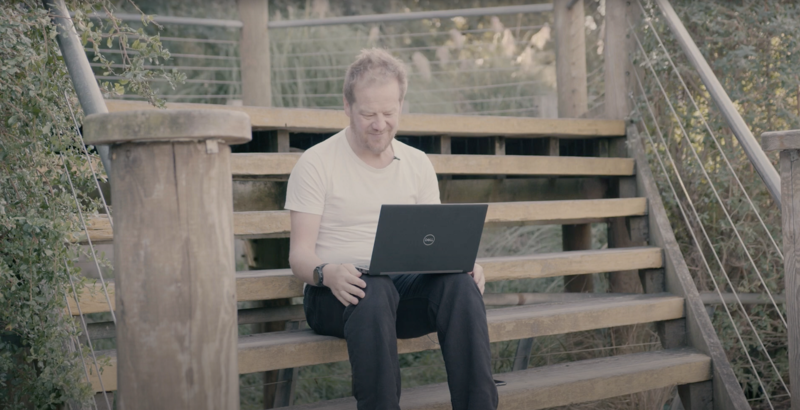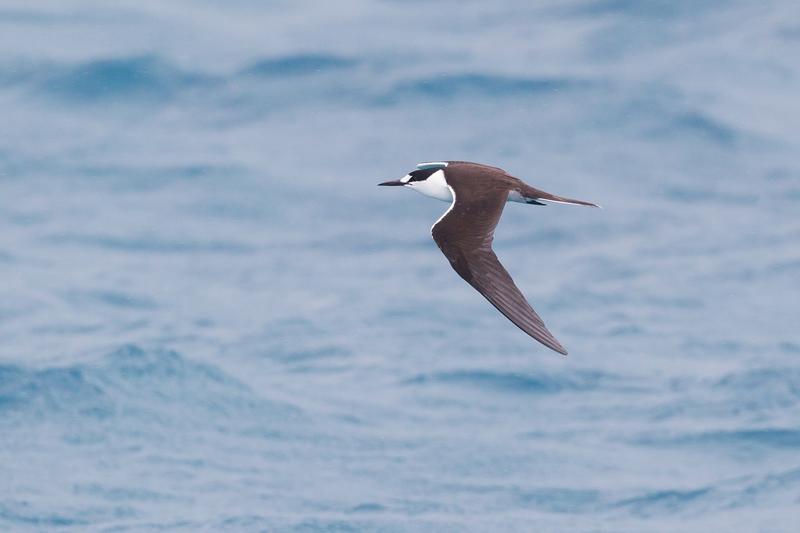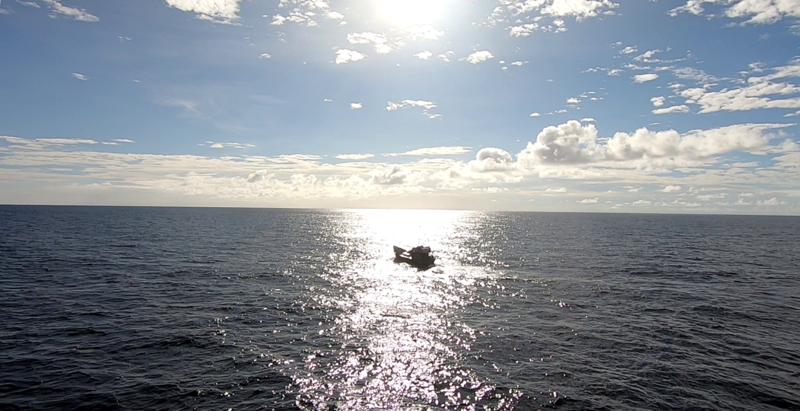Bry's Diaries (part two)
Dr Bryan (Bry) Wilson, coral biologist in the Department of Zoology, and Oxford’s own intrepid explorer, shares further details of his recent expedition

Bry and his colleagues have been carrying out some crucial research on coral reefs in the Chagos Archipelago, an enchanting, endangered corner of the Indian Ocean. We posted some of Bry’s diary entries with you in December and, as promised, now have more entries to share.
These contain just a glimpse of Bry’s important work though, so if you’d like to find out more, why not drop him a line – he's on Twitter right here.

V – Entering the British Indian Ocean Territory
As if the shifting horizon and rolling deck beneath my feet aren’t bewildering enough, we apparently entered the British Indian Ocean Territory at 3.27am this morning and, it being in another time zone, the clocks have gone forward.
Of course, I had no idea and went about my day as normal, waking far too late for breakfast and hoping that I was up just late enough to be early for lunch. Imagine the disappointment of my growling stomach at discovering the time change and thus realising I’d inconveniently arisen at exactly the halfway point between breakfast and lunch. But hey, that’s why we invented ‘elevenses’.
To be fair, I struggle even to remember what day it is on expedition. Without the semblance of order that the five-day working week brings, days roll by, one into another, my mobile phone the only anchor point of the Gregorian calendar. Luckily, it turns out to be a Monday today, which means that my ‘bed day’ yesterday can be effortlessly passed off as a religious day of rest.
Taking my cup of tea and inflatable chair (teabags and the blow-up seat being quite literally the first, most essential things on my expedition kit list), I head up to the fore deck, check the position of the sun (using my finger and thumb held aloft at a jaunty angle, so that the crew on the bridge above can appreciate my being ‘nautical’, in lieu of my absent tattoos) and set my chair down in the shade of the ship, gazing out to port in the mid-morning sun, already strong.
As a mostly land-based marine biologist, I’ve struggled to remember which sides are ‘port’ and ‘starboard’ until only recently, when I worked out all by myself that ‘port’ has exactly the same number of letters as ‘left’, and ‘starboard’ doesn’t. Anyways, as I sit there port side, sipping my tea and beginning the long, drawn-out process of waking up, I notice something tangibly different adrift on the stiff sea breeze, a sound other than the relentless background hum of the ship. Bird calls! And as if summoned to me by the mere realisation of the fact, a beautiful charcoal-grey sooty tern hurtles over the deck in front of me from somewhere stage right and then comedically (to this heartless observer) struggles to land on the air-conditioning outlet in the buffeting winds.

Sooty tern - Shutterstock
Again, maybe it’s my mostly terrestrial existence, but there’s something immensely comforting about seeing birds this far out to sea, and thus the suggestion that there must be land nearby. Of course, if that bird you happened upon was an albatross (as the Rime of the Ancient Mariner once spoke), it would be much less comfort when you discovered that they’re often at sea and on the wing for months on end, possibly hundreds of miles from the nearest island. In this case, it turns out that our closest terra firma is Gann, some 141 nautical miles north of us and the southernmost island in the Maldivian Archipelago. Small wonder that exhausted little tern needed a rest.
Soon thereafter, however, we are joined by several more of its winged brethren, the much larger boobies, which wheel and swoop around the front of the ship, lunging for the flying fish that are panicked by our looming wake. I have to be honest, I never tire of standing at the stem of the bow (the foremost point of the vessel) and watching as the fish burst forth from the water, skittering across the sea’s surface in random directions, ‘wings’ (actually specially adapted pectoral fins) held aloft, carrying them sometimes hundreds of metres away.
And in the game I’ve invented to pass the time, the holler of joy when a boobie scores fifty points with some spectacular stunt flying to pick one off mid-air. I’m almost certain that one time I saw a boobie catch a hapless gliding fish by way of an inverted barrel roll and on that particular occasion, awarded said bird a bonus one hundred points for undeniable style.
Such are the things we do to pass the time of day out here, as, shipbound, we trundle laboriously onwards, unimpeded by any demands on our being, other than those of waking, eating and sleeping. As the sun begins to set later that day though, there is a jarring reminder of the outside world when the order goes around to ensure that every porthole around the vessel is closed and all exterior lights are extinguished during the night. Now that we’ve entered the marine-protected area, we are officially on patrol for illegal fishing activities, and we ‘go dark’…
VI – The north-east corner of the Great Chagos Bank
In what was something of a revelation for all seagoing folk aboard the Good Ship Grampian Frontier, we awaken this morning to calm flat seas, blue cloudless skies and a gentle (if somewhat sultry) breeze, nary a white horse in sight. It felt like we’d passed through Purgatory and come out smiling the other side: a beautiful day to be alive. And if that wasn’t enough, a call down from the bridge mid-morning alerts us to spinner dolphins off the starboard side, and several hundred kilos of marine biologist simultaneously rush out to lean over the guard rail.
It’s hard not to grin from ear to ear at what appears to be the pure and unequivocal enjoyment of the dolphins as they ride the inside of the boat’s wake, streaking past perilously close to the hull, the occasional daredevil leaping in front of the bow. And then just as quickly as they appeared, they vanish, whether tiring of the chase, bored with the game or simply deciding to peel off and spend an hour or two launching themselves into the air in their eponymous aerial acrobatics – we can only guess at what passes through a spinner dolphin’s mind.
I’d like to think it’s a sense of wonderment at why all other animals on this overwhelmingly blue planet don’t share their lifestyle choices of uninhibited curiosity, open playfulness and general wanderlust. After all, we don’t have much time here.
VII – Somewhere in the Great Chagos Bank
So attuned have I become to the regular boat-related movement and background cacophony around me that any small difference in my surroundings now registers almost immediately. And this morning, from my bed, I instantly note that we’ve picked up speed. Less tangible is the overriding (almost Sherlockian) sense that something is afoot. There are hurried footsteps in the corridors outside, a sense of urgency brimming over from the passers-by.

We’ve apprehended an illegal fishing vessel.
Pulling on a pair of shorts, I practically leap up to the fore deck two steps at a time, in my haste to see not only first hand what this criminal activity actually involves, but also as something of a welcome break from the last six days of routine maritime trundling. And it seems that I’m the last of the expedition crew to arrive at the scene. I find them clustered around the guard rail, just as keen as I am to observe our patrol vessel’s fundamental role in protecting these pristine waters.
There, several hundred metres off our bow, one of the ship’s tenders, a powerful pursuit boat known as the Daughter Craft (or ‘DC’), is idling twenty or thirty metres from a brightly painted and somewhat rickety wooden vessel, a number of sheepish-looking fishermen standing out on its deck. However, it’s not the apparent awkwardness of this standoff that first strikes me, nor the garish paintwork or seemingly out-of-place Christmas lights festooned around the single cabin: it’s the stench. A thick, pungent ammonia hits the back of the throat, faintly stinging the nostrils, which sadly can mean only one thing – dead sharks. Even from several hundred metres away, it’s uncomfortable to loiter too long on deck whilst downwind, and I’m absolutely astounded that the fishers clearly endure that almost blinding, industrial aroma for weeks on end.
Whilst we’re all horrified by what we’ve come across, as marine biologists all, there’s also something of a morbid curiosity to see the catch – it’s often the only chance we’ll get to see what we’re actually diving amongst out of the water. There having been scientific voyages of some kind to this part of the world now for over forty years, and we’ve all heard the tales of the monsters that lurk in the depths below. I’m certainly not implying any malice or evil intent on behalf of these extraordinarily beautiful and perfectly evolved creatures, but merely the historic reports of their size and number.
Previous expeditions from a decade or more back have regaled us with stories around cosy and candlelit pub tables of incredible encounters – of being chased out of the water by fearsome and powerfully built bull sharks (the species thought by many to be the most dangerous) of four metres or more in length; of half-seen glimpses in murky seas of the elegantly striped flanks of tiger sharks stretching more than five metres from nose to tail; of divers surrounded by shivers of sharks (the collective noun for these apex predators) numbering greater than forty. There’s no denying that I’ve been accompanied in the waters here by more sharks than anywhere else I’ve dived in the world, but it’s a classic case of shifting baselines.
This is a paradigm (more widely reported only recently) whereby an ecological measurement is defined at a contemporary time by researchers with no historic point of context. It’s classically demonstrated on any expedition that mixes veteran marine biologists with younger students, usually after the latter return from a dive agog at the wonders of what they’ve seen, only to be berated by the former, ‘these bloody reefs aren’t a patch on what they were twenty years ago, sunshine...’. And whilst the younger scientists (among whom I still count myself, but less so with each passing year) will likely roll their eyes, there’s more often than not an unfortunate truth to it. As one of my ‘veteran’ (and some might say ‘bitter’) colleagues and friends on the other side of the world is inclined to say after dives, ‘well, that reef will likely never again look better than it did today’.
And indeed, when we’ve glanced over the evidence of hundreds of illegally fished shark carcasses lined up on a quayside awaiting inspection, it does increasingly feel like a losing battle – especially here in the Chagos Archipelago, when we consider that there’s only one active patrol vessel covering an area of ocean the size of France.
Today, though, there’s no such chance of seeing the haul, and all we have is the lingering ammonia smell to fire our imaginations as to what bloody horrors are stored beneath the decks. As a result of the pandemic, one of many things fisheries patrols have had to needfully change is the way these intercepts are handled. In a pre-pandemic world, vessels such as this would have been boarded in situ and photographic and video evidence amassed, prior to the vessel and crew being escorted back to the US Support Facility of Diego Garcia for processing, and ultimately punishment. However, today, and in fact all days such as this since last March, the patrol crew can only maintain a safe distance, collect what evidence they can and send the vessel on its way with a stern warning (and possibly even an admonishing finger) not be caught fishing in the MPA again.
As the brightly coloured boat starts its engine with a huge spout of black smoke, then turns and steams slowly off into the rising sun, it feels like we’re being laughed at, powerless to stop them with their ghastly horde of hacked and dismembered treasures. I return to my cabin, deep in the dark bowls of the ship, angry and frustrated and desperately sad at the injustice of it all. It’s fair ruined my day.
VIII – West of the Great Chagos Bank
Another long day of slowly putt-putting across the vast expanse of the Great Chagos Bank in the relentless equatorial sunshine. These expeditions always tend to remind me that I’m very much a child of the historically ‘Northern’ Hemisphere, and have always enjoyed the eclectic nature of the weather systems of Western Europe – the changing seasons, the year-round lengthening and shortening of the days. Closer to the Equator, the changes seem much less pronounced, as the planet tracks its elliptical route around our Sun. It’s bloody hot all of the time, and the transition from day to night seems to be on some sort of planetary timer switch, stuck on the same two settings for the sun’s inexorable rising and setting.
That’s not to say that the sunrises or sunsets are routine in any way. They are almost without compare, utterly stunning, and every morning and night brings forth a new dramatic tapestry of crimson slashes across a dark blue sky, brought into sharp relief by the epic cloud formations that form here. Our unspoiled ship-based three-hundred-and-sixty-degree view from horizon to distant horizon likely has something to do with our appreciation of them.
And every evening, as the golden sun slips from its heavenly shackles and slides beneath the waves, there’s the hope borne that tomorrow’s awakening and the day ahead will bring some other wondrous thing, in this wild, overwhelmingly beautiful and seemingly boundless paradisiacal emptiness.

Want to find out more?
Read a further article about Bry's work to identify the world's rarest coral.


